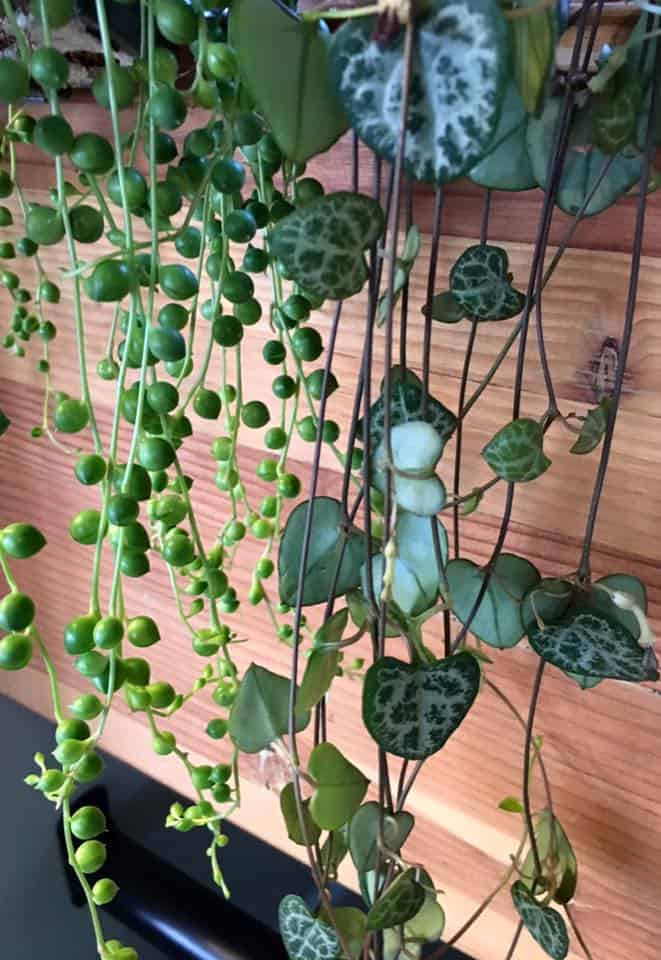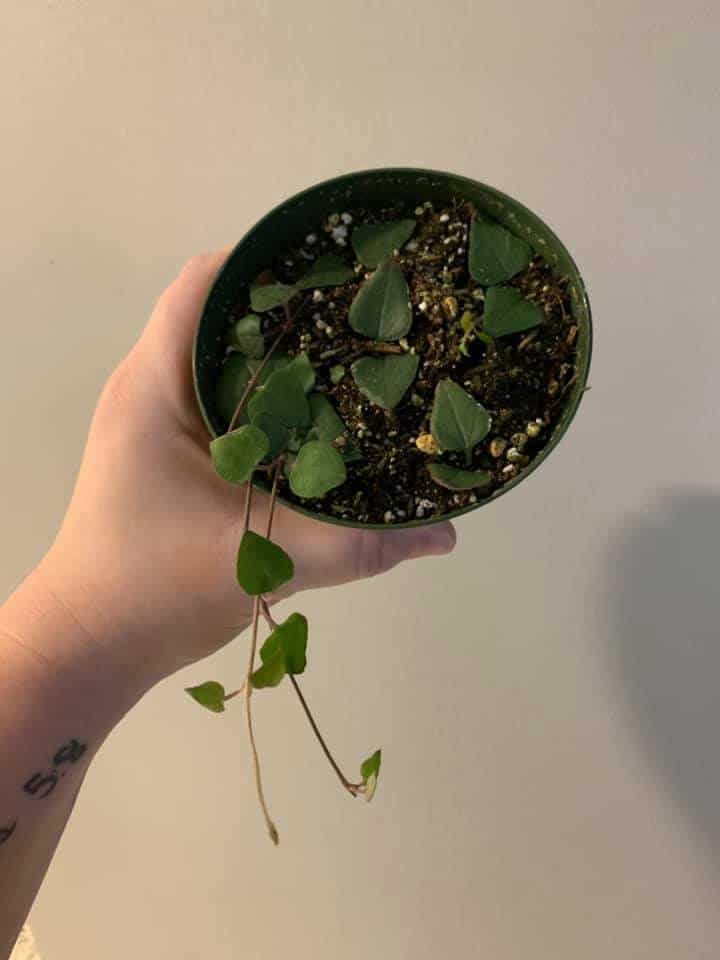Do you fancy growing trailing houseplants with delicate heart-shaped leaves? Then you would love to know more about String of Hearts varieties.
If you want to add some cascading effect to your interior, grow String of Heart plants in hanging baskets.
You can also get these plants in pots located on shelves or window sills.
Table of Contents Show
Popular String of Hearts Varieties
Ceropegia woodii, also popular as String of Hearts, is an evergreen African climber that makes a perfect hanging plant.
It is known for its vining stems that can reach up to 12 feet long with heart-shaped leaves, which gives it the name ‘String of heart.’
There are around 400 known species of the genus Ceropegia and if you wish to add String of Hearts varieties, get some plant ideas.
1. Common String of Hearts
The String of Hearts is the most basic Ceropegia woodii plant native to South Africa, Southern Asia, and Australia.
Also known as the Sweetheart vine, lantern flower, necklace flower, and rosary vine, it displays tiny green leaves with silver mottling, 1-2 cm wide.

The plant reaches about 12 feet in the wild but may only get a few feet long as a houseplant.
- Interestingly, it will grow inch-long, tube-shaped, pale magenta flowers every summer and fall when the conditions are right.
- Keep them in bright indirect light throughout the year and water every week in spring and summer.
- Similarly, choose small pots to allow the roots to be constricted to encourage longer vines.
- It is a natural air purifier that cleanses indoor air pollutants and is non-toxic to humans and animals.
2. Variegated String of Hearts
Variegated String of Hearts is a rare Ceropegia woodii sub-species that boasts pink and green variegated leaves.
However, the leaves are dual-colored instead of single green with silver mottling.
Here are some interesting facts about the Variegated String of Hearts
- A matured plant could grow about 6 feet long and bloom every summer and fall with a bulbous-shaped flower that reaches about an inch long.
- Many growers complain about missing pink leaves. Remember, it will only attain a pink hue when provided with a lot of sunlight, including 3-4 hours of direct sunlight in the morning.
- Therefore, the variegated species is less in supply, making it a relatively rare species.
- Similarly, water every week in the growing season and maintain an ideal temperature and humidity between 65-90°F and 40-50% to ensure healthy growth.
Like Strings of hearts, it is non-toxic to pets and children.
3. String of Hearts Silver Glory
Silver Glory String of Hearts is another widespread Ceropegia sub-species often found as the hanging plant in many warm locations.
However, the plant will only attain a height of 2-4 feet in length but boasts bushier foliage.
Although a String of Heart, it has lily pad-shaped leaves that are not entirely heart-shaped like the original plant.
- Expect to find 2 cm long pinkish-purple, lantern-shaped flowers every spring and summer.
- Provide warm conditions at all times to boost healthier foliage and about 7-10 hours of bright indirect sunlight.
- It does relatively well in temperatures of 70-85°F and 40-50% humidity.
4. Durban String of Spades
Ceropegia woodii ‘Heartless’ is popularly known as String of Spades or Durban String because of its diamond-shaped leaves.
The diamond-shaped leaves are often pointed than the regular String of Hearts that display a patterned mix of green and white color.
- The plant would reach only a height of 10 cm but often spreads over 3 feet in length.
- The lantern-shaped flowers bloom every spring and summer in a pink-purple hue.
- Water it sparsely, about every two weeks, and keep it away from direct sunlight.
- This plant would take almost five years to reach maturity and attain full height.
Native to South Africa, it typically prefers a dry climate, usually USDA zones 11 or above.
5. Ceropegia Linearis
Ceropegia Linearis is unlike other String of Heart sub-species because its foliage resembles nothing like the others.
Like other String of Heart, Ceropegia Linearis grows over 4 feet within 4-6 years.
- It produces small clusters of brown flowers every summer, lasting for a week before wilting.
- Water the plant every other week in spring and summer but strictly cut back in winter and let it bask in dropping temperatures (54°F).
- You must provide a combination of dry soil, shorter days, and cold nights during dormancy to encourage blooming in summer.
Ceropegia Linearis loves being potbound and requires transplanting every three years.
6. String of Hearts Orange River
As the name suggests, String of Heart Orange River is a unique sub-species that displays orange color beneath the leaves.
Remember, the trailing shoot will bear bushier elongated leaves that may change color from green to light when exposed to brighter conditions.

The leaves are elongated in shapes that do not resemble heart-shaped leaves of other String of Hearts.
- Unlike other sub-species, Orange River grows 6-13 feet when provided with optimal care.
- Provide them with partial shade and water lightly throughout the growing season to maintain optimal humidity.
- The warm-climate-loving plant thrives in temperatures above 80°F.
- The flowers come in the shade of pink-purple every summer, complementing the elongated green leaves.
7. String of Arrows
The String of Arrows is known for its unique sharper leaves that resemble the shape of arrows, hence the name.
However, unlike other String of Hearts varieties, it does not produce colorful leaves.
Sometimes, the foliage color will vary from green and lime to grey or silver.
These plants are succulent-like and do best when neglected slightly.
- To maintain the dry spell, provide bright, indirect sunlight and water sparsely about every two weeks.
- When properly cared for, it will reach about 2-4 feet.
- It prefers a warmer climate with temperatures above 80°F, such as Southern US zones.
From Editorial Team
Offer Care Similar to Tropical or Subtropical Climates
Almost every Ceropegia Woodii sub-species have similar care needs and requirements to attain trailing stems with bushier foliage.
Care to provide bright indirect sunlight, occasional watering to maintain dry spells, succulent-like potting soil, and average humidity levels.
Do not forget to feed a diluted solution of balanced fertilizer monthly in the growing season unless you plan to repot it yearly.


